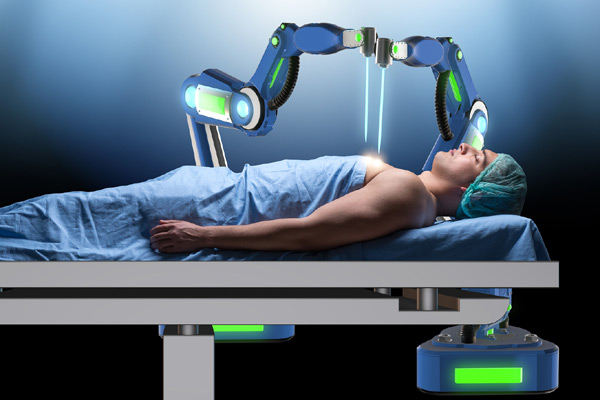
A surgical robot in action
10 cutting-edge medical technologies 'to create big impact'
SANTA CLARA, California, July 11, 2017
Ten cutting-edge medical technologies will create a huge impact on global healthcare in the next two years, according to a study by Frost & Sullivan’s TechVision team.
The analysis profiles the 10 most influential medical devices and imaging technologies that stand out for their market adoptability, market potential, intellectual property (IP) activity, application scope, size of innovation ecosystem, amount of R&D funding received, and market readiness.
These include optical biopsy, surgical robots, smart bandage, super-resolution microscopy, proton beam therapy, artificial organs, neurostimulation, tactile imaging, X-eluting stents, and 3D medical imaging.
The medical device and imaging technology space is experiencing fast-paced research and development (R&D) activity to meet the demand for cutting-edge technologies to cater to an aging population and a high number of patients suffering from chronic diseases, it said.
Medical device developers are striving to align their innovations with the Mega Trend of technology convergence in order to function in and support a smart connected world, the study said.
“As medical device manufacturers collaborate with electronics, sensors and IT companies to create sophisticated medical products, the latter also are recognising healthcare as an important application for their technology platforms,” observed Frost & Sullivan TechVision industry analyst Bhargav Rajan. “Emerging technologies have the potential to replace existing clinical practices, and make healthcare delivery more effective and affordable.”
Nascent technologies, such as tactile imaging and super-resolution imaging, will be commercialised, and technologies such as optical biopsy, eluting stents, and surgical robots, now in the early commercialisation phase, will experience wide-spread adoption across markets.
Despite the huge demand for and potential of these medical device and imaging technologies, their commercialisation is challenged by several regulatory requirements. Further, their prolonged development phase and competitive IP landscape extend the time-to-market and delay the return on investment. Once they hit the shelves, the devices have a long market life, further spurring generational improvements and gradual innovations, prolonging their stay at the top of the pile.
“There is clearly a need for more collaborative and multi-cluster innovation practices in the medical device and imaging innovation space,” noted Rajan. “Leveraging technology platforms from non-healthcare industries can significantly reduce development time, save investment costs, and lower barriers to entry.”
The growing relevance of the new-age medical technologies has attracted the attention of large and small companies alike. Tier-1 companies, traditionally perceived as technology-shy, are beginning to directly or indirectly (investments, tie-ups, and acquisitions) stake a claim to these high-impact markets.
The medical technology industry received funding worth $3 billion in 2016 and with more concerted research and commercialization efforts, it is expected to emerge a hot investment hub in the near future, the study said. - TradeArabia News Service







